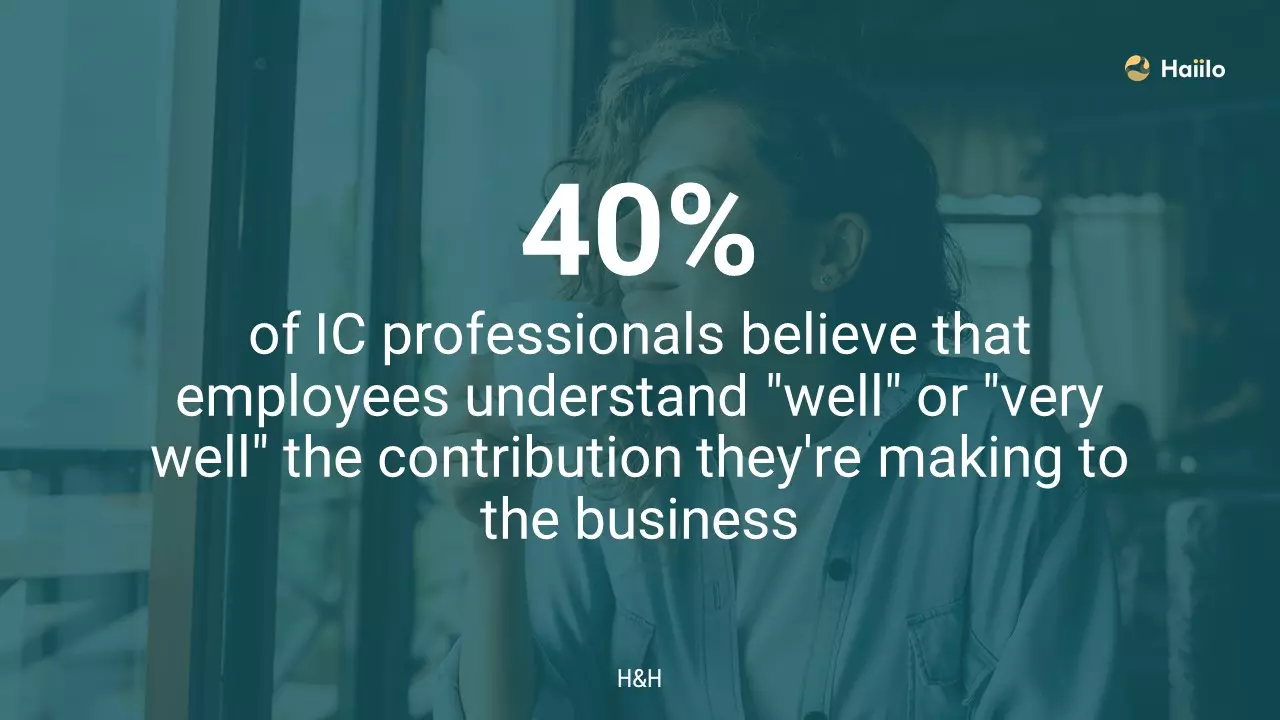Aligning employees with the company’s goals and vision is the key to running a successful business, yet many companies struggle to achieve alignment at all levels of the organization.
When employees understand and share the company’s goals, they are more likely to feel as an integral part of the business.
Alignment across the organization has a direct impact on employee motivation, productivity and engagement.
📕Download our free eBook “How to Boost Internal Communication” and find out how to build an internal communication that drives employee engagement in the workplace.
We’ve asked earlier internal communication experts to share their top priorities and the interviews revealed that alignment across the organization is one of their main focuses.
If you missed this blog post, you can watch the video below that sums up their answers 👇
Related: 14 Internal Communication Experts Share Their Top Priorities
Ensuring that all your employees share your company’s vision is a challenge.
But when it comes to organizational alignment, your internal communication is the key.
Setting clear and measurable business goals is a good start, but if you don’t effectively communicate your goals across your organization, you won’t be able to encourage your employees to work toward a common goal.
We’ve compiled in this blog post 8 reasons why your internal communication is the key to aligning your employees’ personal goals with your company’s vision. Let’s get started!
Top Reasons Why Your Internal Communication Is the Key to Aligning Your Employees with the Company’s Goals
1. Get Everyone on Board
When it comes to internal communication, getting everyone on the same page is one of the main challenges that most businesses — large and small — are facing.
Think about it: IBM found that today, 72% of employees don’t have a full understanding of their company’s strategy.

How can you run your business smoothly if your employees don’t understand what your company’s goals are?
Your employees are your greatest asset, so you’ll have to get everyone on board to outperform your competitors.
You’ll need to make sure that all your employees — not only top and middle management — understand and believe in your company’s mission.
Your Employees Need to Have a Clear Understanding of Your Company’s Mission and Goals
Your employees need to understand where your business is heading so they know how their work impacts the business’s bottom line.
However, it’s usually challenging for employees to measure their contribution to the business.
The internal communications agency H&H found that only 40% of IC professionals believe that employees understand “well” or “very well” the contribution they’re making to the business.

This lack of alignment and information may lower employees’ motivation and engagement.
At the end of the day, it’s your business overall that may suffer from a lack of alignment between your employees’ personal goals and your business goals.
Getting Your Employees’ Buy-In Is Critical to Your Business’s Success
When your employees have a good understanding of your business overall, they are more willing to believe in your product.
You need to make sure that your internal communication drives enthusiasm across your organization.
Related: Internal Communications: Tom Haak on How to Improve Engagement in the Workplace
Employees that are passionate about the business are much more likely to feel inspired, motivated and willing to give their best.
But getting employees’ buy-in doesn’t come easy.
You’ll need to implement internal marketing tactics so you get everyone on board. And that’s where your internal communication comes to place!
Related: Employee Engagement: How to Spread Positivity Throughout Your Workplace
Building an effective and transparent internal communication is the only way to drive enthusiasm across your organization.
2. Empower Your Employees
Helping employees to be successful at their jobs is one of the best ways to build a successful business.
And to do so, you’ll need to make sure that their personal goals are aligned with your business goals.
When your employees know where to find the information they need to do their jobs, are informed about the latest industry trends and share their best practices internally, they can spend more time on important tasks — the ones that have a great and direct impact on your business.
Think about it: McKinsey & Company found that employee productivity increases by 20 to 25% in organizations where employees are connected.
What’s more, 92% of internal communication practitioners agree that internal communication drives financial performance and team productivity.
Related: Employee Empowerment: Where to Start and How to Do It Right
By communicating your business goals to your employees in an effective way, you help them prioritize the right projects and be more proactive in their daily jobs.
That way, they can better anticipate the top industry trends, predict your customers’ needs, and identify the skills they need to develop to be more successful at their jobs.
Connect your employees wherever they are
Try Haiilo, the #1 employee communications platform today
3. Avoid Confusion When Your Business Is Undergoing Change
Building a robust business is an ongoing process.
You’ve probably already changed a few times your brand messages according to your audience’s needs.
Competition is tough and finding a niche market doesn’t come easy. And you’ll probably need to change your brand messages again in the future.
You may launch new products and stop selling other products either because they are not cost-effective anymore, popular, or simply because your competitors have a better brand positioning!
Your business may also be undergoing organizational changes such as mergers or acquisitions.

Think about well-established companies such as Apple, Microsoft or LinkedIn: they’ve all been through major changes!
Changing your brand positioning, business model or brand message is alright as long as you communicate these changes to your employees in an effective way.
Internal communication is critical in organizational changes.
Your employees need to know where your business is heading. Poor communications in change management may lead to confusion and even panic across your organization!
To avoid such a situation, you’ll need to communicate to your entire workforce the changes your organization is undergoing, the reasons why these changes are happening, and the impacts they may have on their jobs.
Related: Change Management: Definition, Best Practices & Examples
Developing a transparent communication is one of the best ways to make sure your employees understand the changes your organization is undergoing.
4. Create Synergy
Communicating your business goals and your company’s mission is one of the best ways to encourage your employees to work toward a common goal.
When your employees are aligned with your business goals, they’re more likely to collaborate in an effective way because each of them knows what kind of help or support the others need from them.
Aligning your employees with your business goals is also a great way to create a sense of commitment across the organization.
That way, employees know how their work impacts the business’s bottom line and how they can improve personal but also team performance in the workplace.
5. Build Trust in the Workplace
PwC revealed that 55% of business leaders strongly believe a lack of trust in the workplace constitutes a foundational threat to their business.
Another study found that compared with employees working at low-trust companies, employees working at companies that cultivate trust:
- Feel 74% less stressed
- Are 106% more energetic at work
- Are 50% more productive
- Are 13% less willing to call in sick to work
- Feel 76% more engaged
- Report a 29% higher satisfaction with their lives overall
- Are 40% less likely to cope with burnout
These stats are amazing, aren’t they?
Now, the question is how to effectively build trust in the workplace?
The answer is quite simple here: it’s all about your internal communication!
More precisely, it’s all about cultivating an open and transparent internal communication.
Think about it: when you share the company’s goals and strategy with your employees, you show that you trust them and that you want them to get involved in the big picture.
Put differently, you show them that you count on them to reach these goals!
Internal communication is critical when it comes to building trust in the workplace.
In most businesses, the company’s goals are not explained to all the employees while trust is essential to building a successful business.
“The most successful leaders are the best communicators” – Glen Llopis
If you want to build a culture of trust, start communicating the company’s strategy to your employees.
Encourage them to ask questions, discuss these goals internally, and think how they can directly contribute to these goals.
6. Improve Employee Engagement
Informed, trusted and valued employees are more likely to feel engaged.
When you communicate the company’s goals to your employees, you inform them, trust them and value them because you are convinced they are the right talent to reach these goals.
Key Statistics on Employee Engagement

When it comes to employee engagement, it’s not only about offering great salaries and benefits, creating amazing office spaces, or allowing flexible working hours.
Your employees expect more from you — they want to be considered as business partners that are able to impact your business.
Open up about the company’s goals and where the business is heading.
Related: 5 Internal Communications Best Practices for Driving Engagement [Infographic Included]
Having great internal communication in place is one of the best ways to encourage your employees to go the extra mile for your business!
7. Strengthen Your Brand Image
Yes, your internal communication has a direct impact on your brand image and employer brand!
Your employees talk about your company on social media, forums and websites such as Glassdoor before you even know it!
Word-of-mouth can either improve your brand image or destroy it, literally.
You need to make employee experience one of your top priorities, so your employees enjoy working at your company.
And one of the best ways to deliver a great employee experience is to build an effective internal communication strategy.
When employees get frustrated at work, it’s most of the time because of poor communication and a lack of alignment across the organization:
- Employees don’t know where to find the information they need
- They don’t know where the business is heading
- They have difficulties to measure the impact of their work on the business overall
- They feel like their efforts are under-estimated
- They don’t feel valued
When your internal communication drives motivation and inspiration in the workplace, your employees are more likely to spread the word about your business and help you attract top talent as well!
Related:10 Shocking Internal Communications Stats You Can’t Ignore
8. Your Internal Communication Is the Cornerstone of Your Business
Last but not least, your internal communication is key to building a successful business!
When your employees have a great understanding of your business goals, collaborate with their colleagues in an effective way, and understand how their work impacts your business, they’re more likely to go the extra mile for your business!
Organizational alignment drives innovation, enhances cross-departmental collaboration, and improves communication between managers and their teams.
When employees know what your business goals are, they can better coordinate their efforts, share ideas to improve internal processes, and rethink the way they’re working. This translates into higher employee productivity, higher revenues and lower employee turnover.
Final Thoughts
Aligning employees’ personal goals with the company’s strategy is the key to building a successful business. And to do so, you’ll need to build a solid internal communication strategy.
When you communicate your company’s goals to your employees in an effective way, you get everyone on board, empower your employees, create synergy, avoid confusion when your business is undergoing organizational changes, and improve employee engagement in the workplace. Overall, it’s your entire business that benefits from company-wide goal alignment.









